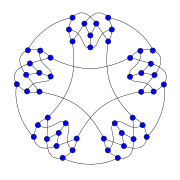Szekeres snark: Difference between revisions
Appearance
Content deleted Content added
m [Pu405]Add: issue. You can use this bot yourself. Report bugs here. |
avoid redirect |
||
| Line 13: | Line 13: | ||
In the [[mathematics|mathematical]] field of [[graph theory]], the '''Szekeres snark''' is a [[snark (graph theory)|snark]] with 50 [[vertex (graph theory)|vertices]] and 75 edges<ref>{{MathWorld|title=Szekeres Snark|urlname=SzekeresSnark}}</ref>. It was the fifth known snark, discovered by [[George Szekeres]] in 1973.<ref>{{cite journal|author=Szekeres, G.|authorlink=George Szekeres|title=Polyhedral decompositions of cubic graphs|journal=Bull. Austral. Math. Soc.|volume=8|pages=367–387|year=1973|doi=10.1017/S0004972700042660|issue=3}}</ref> |
In the [[mathematics|mathematical]] field of [[graph theory]], the '''Szekeres snark''' is a [[snark (graph theory)|snark]] with 50 [[vertex (graph theory)|vertices]] and 75 edges<ref>{{MathWorld|title=Szekeres Snark|urlname=SzekeresSnark}}</ref>. It was the fifth known snark, discovered by [[George Szekeres]] in 1973.<ref>{{cite journal|author=Szekeres, G.|authorlink=George Szekeres|title=Polyhedral decompositions of cubic graphs|journal=Bull. Austral. Math. Soc.|volume=8|pages=367–387|year=1973|doi=10.1017/S0004972700042660|issue=3}}</ref> |
||
As a snark, the Szekeres graph is a connected, bridgeless [[cubic graph]] with [[chromatic index]] equal to 4. The Szekeres snark is [[planar graph|non-planar]] and [[hamiltonian |
As a snark, the Szekeres graph is a connected, bridgeless [[cubic graph]] with [[chromatic index]] equal to 4. The Szekeres snark is [[planar graph|non-planar]] and [[hamiltonian path|non-hamiltonian]] but is [[hypohamiltonian graph|hypohamiltonian]].<ref>{{MathWorld|title=Hypohamiltonian Graph|urlname=HypohamiltonianGraph}}</ref> |
||
Another well known snark on 50 vertices is the [[Watkins snark]] discovered by John J. Watkins in 1989.<ref>Watkins, J. J. "Snarks." Ann. New York Acad. Sci. 576, 606-622, 1989.</ref> |
Another well known snark on 50 vertices is the [[Watkins snark]] discovered by John J. Watkins in 1989.<ref>Watkins, J. J. "Snarks." Ann. New York Acad. Sci. 576, 606-622, 1989.</ref> |
||
Revision as of 17:01, 23 June 2012
| Szekeres snark | |
|---|---|
 The Szekeres snark | |
| Named after | George Szekeres |
| Vertices | 50 |
| Edges | 75 |
| Chromatic number | 3 |
| Chromatic index | 4 |
| Properties | Snark Hypohamiltonian |
| Table of graphs and parameters | |
In the mathematical field of graph theory, the Szekeres snark is a snark with 50 vertices and 75 edges[1]. It was the fifth known snark, discovered by George Szekeres in 1973.[2]
As a snark, the Szekeres graph is a connected, bridgeless cubic graph with chromatic index equal to 4. The Szekeres snark is non-planar and non-hamiltonian but is hypohamiltonian.[3]
Another well known snark on 50 vertices is the Watkins snark discovered by John J. Watkins in 1989.[4]
Gallery
-
The chromatic number of the Szekeres snark is 3.
-
The chromatic index of the Szekeres snark is 4.
-
Alternative drawing of the Szekeres snark.
References
- ^ Weisstein, Eric W. "Szekeres Snark". MathWorld.
- ^ Szekeres, G. (1973). "Polyhedral decompositions of cubic graphs". Bull. Austral. Math. Soc. 8 (3): 367–387. doi:10.1017/S0004972700042660.
- ^ Weisstein, Eric W. "Hypohamiltonian Graph". MathWorld.
- ^ Watkins, J. J. "Snarks." Ann. New York Acad. Sci. 576, 606-622, 1989.


